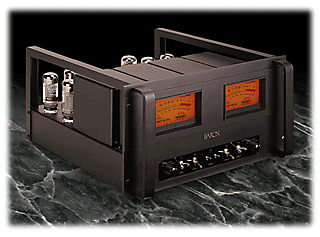
NO RESERVE -- MESA BARON TUBED STEREO POWER AMPLIFIER Much sought after, limited production Mesa Engineering tube amplifier in like new condition. A rare example of audiophile-class power transformed into a fully adjustable musical instrument. 32 different combinations of settings, enables you to literally tune this power amp to any type of music. The Baron offers the remarkable ability to drill down, and tailor the performance to accommodate room environment or speaker type. 150 watts / channel in full pentode mode. Perfect working and cosmetic condition. From a clean, smoke-free environment. Bid with confidence. Will be carefully packed, double boxed, shipped insured. UPS Ground anywhere in the lower 48. Approx. 85 lbs ship wgt Description: Tubed dual-mono power amplifier with output power meters (switchable between 15W FS and 150W FS), "Tandem State Imaging," 4 ohm and 8 ohm output transformer taps, and four selectable levels of overall negative feedback, from 0dB to 8dB. Tube complement: four 12AX7s (input); twelve 5881s (output). Rated output power: about 60Wpc into 8 ohms (17.8dBW) (full triode operation, zero feedback) to 150Wpc into 8 ohms (21.8dBW) (full pentode operation, 8dB feedback). Frequency response, THD, S/N ratio, sensitivity, and output impedance not specified. Input impedance: 60k ohms single-ended (110k ohms available with a simple internal modification). Dimensions: 19" W by 8.75" H by 14.5" D. Weight: 65 lbs. Here's a review excerpt from Stereophile magazine, January 1997... " Now, I've been around; listened to all kinds of sounds, experienced a lot of live music, and heard some extraordinary sound systems in my time—I always thought I had pretty good aural reference points. But it was humbling to finally experience just how much sonic impact and dimensionality a great power amp imparts to a sound system. When you visit a fine high-end store, one of the biggest challenges facing a salesman is helping you to zero in on what kind of amp will best suit your system, acoustic environment, and musical tastes. You might be attracted to the warmth and airiness of a low-powered tube amp, but if your listening tastes run beyond jazz and classical to rock, hip-hop, and other highly processed source material, this type of amp probably won't satisfy you in the long run. And while a high-powered solid-state amp might convey the sonic impact and immediacy you crave—especially in the low end—the lack of subtlety and detail on acoustic music may grow tiresome after a while. Which is part of what makes the Mesa Baron such a remarkable performer—it's a true musical instrument. I'm not going to undertake a technical analysis, A/B it against other amps, or make outrageous subjective claims for it. There are lots of great tube and solid-state amps out there that I'd be thrilled to own. What I will tell you is that the sound of this dual-mono, all-tube amplifier has made me deliriously happy. Its remarkable level of flexibility and musicality recommend it to economically impaired music lovers for whom high-end performance has always been just out of reach—and possibly even to those of you for whom cost is no object. When I first auditioned my speakers in tandem with the Mesa Baron, I used Emmylou Harris's Wrecking Ball (Asylum 61854-2) to impress my wife. Producer/guitarist Daniel Lanois's avant-garde vision of rustic Americana has lots of ambient detail and some outrageous low end, featuring a clear, bottom-heavy portrayal of the toms and bass drum (recorded with ribbon mikes). Well, her eyes were popping out. "The first time you played me these speakers I was feeling the sound in my pelvis, but now I'm experiencing it right in the heart," she marveled. "Well, there you are," I enthused. "The true tube chakra." Mesa Baron Specs True dual mono, fixed bias, vacuum tube push-pull Class A/B stereo power amplifier Patent-Pending Tandem State Imaging circuitry: four stages of adjustable Negative Feedback [ 0, 2, 4, 8dB ] interface with four selectable power tube configurations [ all pentode, all triode, 2/3 pentode + 1/3 triode, 2/3 triode + 1/3 pentode] to offer 16 sonic tuning options; affects soundstage depth and width, dynamics, frequency extension, timbral balance, speaker/amp interface - all variables can be adjusted during playback with a simple flip of a switch or the turn of knob. 60K or 110K input impedance [ user selectable ] 12 x 5881s output tubes, 4 x 12AX7As input/predriver tubes 55W/Ch all Triode 85 W/Ch 2/3 Triode + 1/3 Pentode 120 W/Ch 2/3 Pentode + 1/3 Triode 150 W/Ch full Pentode Separate on/off, standby and meter light switches for each channel. Dual powercords; separate power- and output transformers for each channel. Proprietary ceramic tube sockets with silver contacts. Rubber iso-mounted transformers for quiet operation. Double-sided printed circuit boards with three-ounce high- purit copper traces and glass-epoxy base with plated-thru contacts. Audiophile-grade metal film capacitors. Flying leads point-to-point soldering to switches, connectors and transformers; no "quick-connects" or push-on terminals. VU meters can be set for 150W or 15W peak to show greater deflection of needle. Meters are used to conveniently adjust bias and balance. Weight: 65 lbs / 85 lbs in box. Dimensions: 19" wide x 14.5" deep x 8.75" high (inches). Tandem State Imaging Our patent-pending Tandem State Imaging is a unique feature that allows the listener to "dial in" or "tune" the amplifier to match listening preferences and system requirements. The sixteen available combinations are mechanical adjustments which may be engaged during playback, making the effects immediate and easily observable. The output power tubes of the Baron, 5881s [an industrial, rugged version of the 6L6], can be wired for pentode or triode operation. The Baron's unique circuitry wires them for both operations such that individual pairs of output tubes may be assigned a different mode, simultaneously. This is a new concept in tube amplification and makes it possible to combine the distinct sonic chracteristics of either mode of operation, in user-adjustable increments. Front to 10th row perspective, thundering dynamics to subtle micro detail, full frequency extension to midrange emphasis, subtle tonal shadings... these parameters, and more, can be addressed by Tandem State Imaging. None of it requires any prior exposure to High-End audio or tube equipment, merely an enthusiasm for great sound and music and a willingness to experiment with different settings to explore their particular value in a given application. The Mesa/Boogie professional heritage insures industrial-strength build quality and reliability, and our 25 years of experience with vacuum tubes, expressed in more than 12 patents for tube design, guarantees fully matured technology equally at home in a stadium, concert hall or private living room. The current resurgence of interest in tube designs in the consumer markets proves what professional musicians have known all along: vacuum tubes sound different - and most people feel, better!"For this aural pilgrim, the Mesa Baron is the truth, the whole truth and nothing but the truth." Chip Stern, Stereophile "The Baron is a fantastic amplifier at a very reasonable price." Bruce Manoly, Positive Feedback "One of the best sound-for-the-dollar components in high-end audio today." Mark Block, The Audiophile Voice "Seductively sweet-sounding." John Atkinson, Stereophile "It's as close to what I'd imagine an all-valve Krell would sound like if Dan D'Agostino ever got a jones for tubes." Ken Kessler, HiFi News and Record Review "Knocking, no pounding, on state-of-the-art's door... one of the best values in Audio." Tom Miiller, The Audio Adventure "The Baron fills my sonic wish list as beautifully as I could have hoped for: Transparency, high resolution, tonal neutrality, liquid midrange, soundstage depth, extended but sweet highs, powerful yet controlled bass." Mark Block, Audiophile Voice "It's only serious competition comes from amps costing two or three times as much." Dick Olsher, FI "The Baron entered this household under the least favorable of circumstances: it followed the $ 30,000.- Audio Research Reference 600 power amplifier... That's a tough act to follow, but - even with its more earthly price, the Baron damn near stole the show!" Tom Miiller, The Audio Adventure
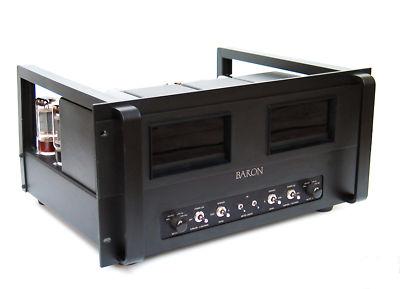
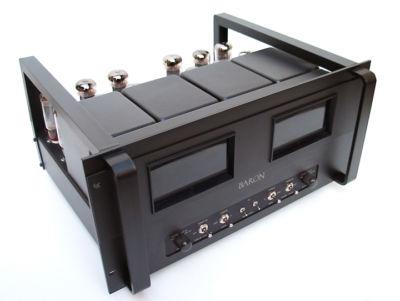
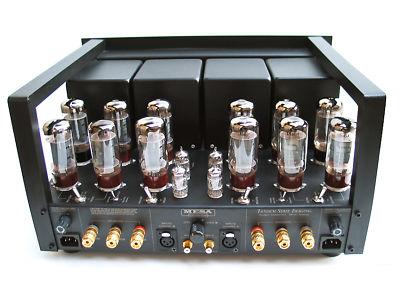
NO RESERVE -- MESA BARON TUBED STEREO POWER AMPLIFIER Much sought after, limited production Mesa Engineering tube amplifier in like new condition. A rare example of audiophile-class power transformed into a fully adjustable musical instrument. 32 different combinations of settings, enables you to literally tune this power amp to any type of music. The Baron offers the remarkable ability to drill down, and tailor the performance to accommodate room environment or speaker type. 150 watts / channel in full pentode mode. Perfect working and cosmetic condition. From a clean, smoke-free environment. Bid with confidence. Will be carefully packed, double boxed, shipped insured. UPS Ground anywhere in the lower 48. Approx. 85 lbs ship wgt Description: Tubed dual-mono power amplifier with output power meters (switchable between 15W FS and 150W FS), "Tandem State Imaging," 4 ohm and 8 ohm output transformer taps, and four selectable levels of overall negative feedback, from 0dB to 8dB. Tube complement: four 12AX7s (input); twelve 5881s (output). Rated output power: about 60Wpc into 8 ohms (17.8dBW) (full triode operation, zero feedback) to 150Wpc into 8 ohms (21.8dBW) (full pentode operation, 8dB feedback). Frequency response, THD, S/N ratio, sensitivity, and output impedance not specified. Input impedance: 60k ohms single-ended (110k ohms available with a simple internal modification). Dimensions: 19" W by 8.75" H by 14.5" D. Weight: 65 lbs. Here's a review excerpt from Stereophile magazine, January 1997... " Now, I've been around; listened to all kinds of sounds, experienced a lot of live music, and heard some extraordinary sound systems in my time—I always thought I had pretty good aural reference points. But it was humbling to finally experience just how much sonic impact and dimensionality a great power amp imparts to a sound system. When you visit a fine high-end store, one of the biggest challenges facing a salesman is helping you to zero in on what kind of amp will best suit your system, acoustic environment, and musical tastes. You might be attracted to the warmth and airiness of a low-powered tube amp, but if your listening tastes run beyond jazz and classical to rock, hip-hop, and other highly processed source material, this type of amp probably won't satisfy you in the long run. And while a high-powered solid-state amp might convey the sonic impact and immediacy you crave—especially in the low end—the lack of subtlety and detail on acoustic music may grow tiresome after a while. Which is part of what makes the Mesa Baron such a remarkable performer—it's a true musical instrument. I'm not going to undertake a technical analysis, A/B it against other amps, or make outrageous subjective claims for it. There are lots of great tube and solid-state amps out there that I'd be thrilled to own. What I will tell you is that the sound of this dual-mono, all-tube amplifier has made me deliriously happy. Its remarkable level of flexibility and musicality recommend it to economically impaired music lovers for whom high-end performance has always been just out of reach—and possibly even to those of you for whom cost is no object. When I first auditioned my speakers in tandem with the Mesa Baron, I used Emmylou Harris's Wrecking Ball (Asylum 61854-2) to impress my wife. Producer/guitarist Daniel Lanois's avant-garde vision of rustic Americana has lots of ambient detail and some outrageous low end, featuring a clear, bottom-heavy portrayal of the toms and bass drum (recorded with ribbon mikes). Well, her eyes were popping out. "The first time you played me these speakers I was feeling the sound in my pelvis, but now I'm experiencing it right in the heart," she marveled. "Well, there you are," I enthused. "The true tube chakra." Mesa Baron Specs True dual mono, fixed bias, vacuum tube push-pull Class A/B stereo power amplifier Patent-Pending Tandem State Imaging circuitry: four stages of adjustable Negative Feedback [ 0, 2, 4, 8dB ] interface with four selectable power tube configurations [ all pentode, all triode, 2/3 pentode + 1/3 triode, 2/3 triode + 1/3 pentode] to offer 16 sonic tuning options; affects soundstage depth and width, dynamics, frequency extension, timbral balance, speaker/amp interface - all variables can be adjusted during playback with a simple flip of a switch or the turn of knob. 60K or 110K input impedance [ user selectable ] 12 x 5881s output tubes, 4 x 12AX7As input/predriver tubes 55W/Ch all Triode 85 W/Ch 2/3 Triode + 1/3 Pentode 120 W/Ch 2/3 Pentode + 1/3 Triode 150 W/Ch full Pentode Separate on/off, standby and meter light switches for each channel. Dual powercords; separate power- and output transformers for each channel. Proprietary ceramic tube sockets with silver contacts. Rubber iso-mounted transformers for quiet operation. Double-sided printed circuit boards with three-ounce high- purit copper traces and glass-epoxy base with plated-thru contacts. Audiophile-grade metal film capacitors. Flying leads point-to-point soldering to switches, connectors and transformers; no "quick-connects" or push-on terminals. VU meters can be set for 150W or 15W peak to show greater deflection of needle. Meters are used to conveniently adjust bias and balance. Weight: 65 lbs / 85 lbs in box. Dimensions: 19" wide x 14.5" deep x 8.75" high (inches). Tandem State Imaging Our patent-pending Tandem State Imaging is a unique feature that allows the listener to "dial in" or "tune" the amplifier to match listening preferences and system requirements. The sixteen available combinations are mechanical adjustments which may be engaged during playback, making the effects immediate and easily observable. The output power tubes of the Baron, 5881s [an industrial, rugged version of the 6L6], can be wired for pentode or triode operation. The Baron's unique circuitry wires them for both operations such that individual pairs of output tubes may be assigned a different mode, simultaneously. This is a new concept in tube amplification and makes it possible to combine the distinct sonic chracteristics of either mode of operation, in user-adjustable increments. Front to 10th row perspective, thundering dynamics to subtle micro detail, full frequency extension to midrange emphasis, subtle tonal shadings... these parameters, and more, can be addressed by Tandem State Imaging. None of it requires any prior exposure to High-End audio or tube equipment, merely an enthusiasm for great sound and music and a willingness to experiment with different settings to explore their particular value in a given application. The Mesa/Boogie professional heritage insures industrial-strength build quality and reliability, and our 25 years of experience with vacuum tubes, expressed in more than 12 patents for tube design, guarantees fully matured technology equally at home in a stadium, concert hall or private living room. The current resurgence of interest in tube designs in the consumer markets proves what professional musicians have known all along: vacuum tubes sound different - and most people feel, better!"For this aural pilgrim, the Mesa Baron is the truth, the whole truth and nothing but the truth." Chip Stern, Stereophile "The Baron is a fantastic amplifier at a very reasonable price." Bruce Manoly, Positive Feedback "One of the best sound-for-the-dollar components in high-end audio today." Mark Block, The Audiophile Voice "Seductively sweet-sounding." John Atkinson, Stereophile "It's as close to what I'd imagine an all-valve Krell would sound like if Dan D'Agostino ever got a jones for tubes." Ken Kessler, HiFi News and Record Review "Knocking, no pounding, on state-of-the-art's door... one of the best values in Audio." Tom Miiller, The Audio Adventure "The Baron fills my sonic wish list as beautifully as I could have hoped for: Transparency, high resolution, tonal neutrality, liquid midrange, soundstage depth, extended but sweet highs, powerful yet controlled bass." Mark Block, Audiophile Voice "It's only serious competition comes from amps costing two or three times as much." Dick Olsher, FI "The Baron entered this household under the least favorable of circumstances: it followed the $ 30,000.- Audio Research Reference 600 power amplifier... That's a tough act to follow, but - even with its more earthly price, the Baron damn near stole the show!" Tom Miiller, The Audio Adventure
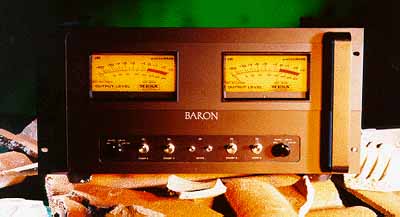
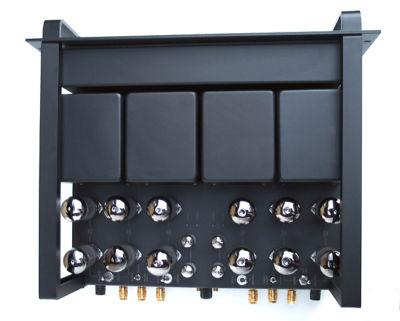
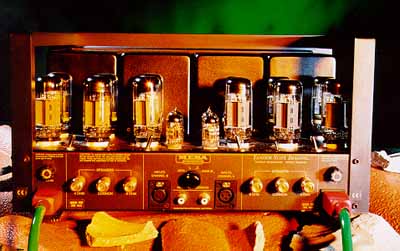
NO RESERVE -- MESA BARON TUBED STEREO POWER AMPLIFIER Much sought after, limited production Mesa Engineering tube amplifier in like new condition. A rare example of audiophile-class power transformed into a fully adjustable musical instrument. 32 different combinations of settings, enables you to literally tune this power amp to any type of music. The Baron offers the remarkable ability to drill down, and tailor the performance to accommodate room environment or speaker type. 150 watts / channel in full pentode mode. Perfect working and cosmetic condition. From a clean, smoke-free environment. Bid with confidence. Will be carefully packed, double boxed, shipped insured. UPS Ground anywhere in the lower 48. Approx. 85 lbs ship wgt Description: Tubed dual-mono power amplifier with output power meters (switchable between 15W FS and 150W FS), "Tandem State Imaging," 4 ohm and 8 ohm output transformer taps, and four selectable levels of overall negative feedback, from 0dB to 8dB. Tube complement: four 12AX7s (input); twelve 5881s (output). Rated output power: about 60Wpc into 8 ohms (17.8dBW) (full triode operation, zero feedback) to 150Wpc into 8 ohms (21.8dBW) (full pentode operation, 8dB feedback). Frequency response, THD, S/N ratio, sensitivity, and output impedance not specified. Input impedance: 60k ohms single-ended (110k ohms available with a simple internal modification). Dimensions: 19" W by 8.75" H by 14.5" D. Weight: 65 lbs. Here's a review excerpt from Stereophile magazine, January 1997... " Now, I've been around; listened to all kinds of sounds, experienced a lot of live music, and heard some extraordinary sound systems in my time—I always thought I had pretty good aural reference points. But it was humbling to finally experience just how much sonic impact and dimensionality a great power amp imparts to a sound system. When you visit a fine high-end store, one of the biggest challenges facing a salesman is helping you to zero in on what kind of amp will best suit your system, acoustic environment, and musical tastes. You might be attracted to the warmth and airiness of a low-powered tube amp, but if your listening tastes run beyond jazz and classical to rock, hip-hop, and other highly processed source material, this type of amp probably won't satisfy you in the long run. And while a high-powered solid-state amp might convey the sonic impact and immediacy you crave—especially in the low end—the lack of subtlety and detail on acoustic music may grow tiresome after a while. Which is part of what makes the Mesa Baron such a remarkable performer—it's a true musical instrument. I'm not going to undertake a technical analysis, A/B it against other amps, or make outrageous subjective claims for it. There are lots of great tube and solid-state amps out there that I'd be thrilled to own. What I will tell you is that the sound of this dual-mono, all-tube amplifier has made me deliriously happy. Its remarkable level of flexibility and musicality recommend it to economically impaired music lovers for whom high-end performance has always been just out of reach—and possibly even to those of you for whom cost is no object. When I first auditioned my speakers in tandem with the Mesa Baron, I used Emmylou Harris's Wrecking Ball (Asylum 61854-2) to impress my wife. Producer/guitarist Daniel Lanois's avant-garde vision of rustic Americana has lots of ambient detail and some outrageous low end, featuring a clear, bottom-heavy portrayal of the toms and bass drum (recorded with ribbon mikes). Well, her eyes were popping out. "The first time you played me these speakers I was feeling the sound in my pelvis, but now I'm experiencing it right in the heart," she marveled. "Well, there you are," I enthused. "The true tube chakra." Mesa Baron Specs True dual mono, fixed bias, vacuum tube push-pull Class A/B stereo power amplifier Patent-Pending Tandem State Imaging circuitry: four stages of adjustable Negative Feedback [ 0, 2, 4, 8dB ] interface with four selectable power tube configurations [ all pentode, all triode, 2/3 pentode + 1/3 triode, 2/3 triode + 1/3 pentode] to offer 16 sonic tuning options; affects soundstage depth and width, dynamics, frequency extension, timbral balance, speaker/amp interface - all variables can be adjusted during playback with a simple flip of a switch or the turn of knob. 60K or 110K input impedance [ user selectable ] 12 x 5881s output tubes, 4 x 12AX7As input/predriver tubes 55W/Ch all Triode 85 W/Ch 2/3 Triode + 1/3 Pentode 120 W/Ch 2/3 Pentode + 1/3 Triode 150 W/Ch full Pentode Separate on/off, standby and meter light switches for each channel. Dual powercords; separate power- and output transformers for each channel. Proprietary ceramic tube sockets with silver contacts. Rubber iso-mounted transformers for quiet operation. Double-sided printed circuit boards with three-ounce high- purit copper traces and glass-epoxy base with plated-thru contacts. Audiophile-grade metal film capacitors. Flying leads point-to-point soldering to switches, connectors and transformers; no "quick-connects" or push-on terminals. VU meters can be set for 150W or 15W peak to show greater deflection of needle. Meters are used to conveniently adjust bias and balance. Weight: 65 lbs / 85 lbs in box. Dimensions: 19" wide x 14.5" deep x 8.75" high (inches). Tandem State Imaging Our patent-pending Tandem State Imaging is a unique feature that allows the listener to "dial in" or "tune" the amplifier to match listening preferences and system requirements. The sixteen available combinations are mechanical adjustments which may be engaged during playback, making the effects immediate and easily observable. The output power tubes of the Baron, 5881s [an industrial, rugged version of the 6L6], can be wired for pentode or triode operation. The Baron's unique circuitry wires them for both operations such that individual pairs of output tubes may be assigned a different mode, simultaneously. This is a new concept in tube amplification and makes it possible to combine the distinct sonic chracteristics of either mode of operation, in user-adjustable increments. Front to 10th row perspective, thundering dynamics to subtle micro detail, full frequency extension to midrange emphasis, subtle tonal shadings... these parameters, and more, can be addressed by Tandem State Imaging. None of it requires any prior exposure to High-End audio or tube equipment, merely an enthusiasm for great sound and music and a willingness to experiment with different settings to explore their particular value in a given application. The Mesa/Boogie professional heritage insures industrial-strength build quality and reliability, and our 25 years of experience with vacuum tubes, expressed in more than 12 patents for tube design, guarantees fully matured technology equally at home in a stadium, concert hall or private living room. The current resurgence of interest in tube designs in the consumer markets proves what professional musicians have known all along: vacuum tubes sound different - and most people feel, better!"For this aural pilgrim, the Mesa Baron is the truth, the whole truth and nothing but the truth." Chip Stern, Stereophile "The Baron is a fantastic amplifier at a very reasonable price." Bruce Manoly, Positive Feedback "One of the best sound-for-the-dollar components in high-end audio today." Mark Block, The Audiophile Voice "Seductively sweet-sounding." John Atkinson, Stereophile "It's as close to what I'd imagine an all-valve Krell would sound like if Dan D'Agostino ever got a jones for tubes." Ken Kessler, HiFi News and Record Review "Knocking, no pounding, on state-of-the-art's door... one of the best values in Audio." Tom Miiller, The Audio Adventure "The Baron fills my sonic wish list as beautifully as I could have hoped for: Transparency, high resolution, tonal neutrality, liquid midrange, soundstage depth, extended but sweet highs, powerful yet controlled bass." Mark Block, Audiophile Voice "It's only serious competition comes from amps costing two or three times as much." Dick Olsher, FI "The Baron entered this household under the least favorable of circumstances: it followed the $ 30,000.- Audio Research Reference 600 power amplifier... That's a tough act to follow, but - even with its more earthly price, the Baron damn near stole the show!" Tom Miiller, The Audio Adventure
April 1998Mesa Baron Amplifier
by Marc Mickelson
 Although
it’s rarely bad to be the first publication to print a review of a significant
new piece of high-end audio gear, it’s not all that bad to let others take
their cracks at it before you either. The significance of being at the front of
the line is obvious—and SoundStage! has been successful in this regard—but
being last, or close to it, allows you the luxury of covering a product with the
knowledge that its story—who makes it, what kind of technology is at work,
whether it uses oxygen-free copper or high-purity silver wire—has been told
again and again, so for the most part you can ignore the background information
and concentrate on what’s really important, the product’s sound.
There’s also something appealing about having the last word, maybe because it
sticks in the mind longer (or we just think it does).
Although
it’s rarely bad to be the first publication to print a review of a significant
new piece of high-end audio gear, it’s not all that bad to let others take
their cracks at it before you either. The significance of being at the front of
the line is obvious—and SoundStage! has been successful in this regard—but
being last, or close to it, allows you the luxury of covering a product with the
knowledge that its story—who makes it, what kind of technology is at work,
whether it uses oxygen-free copper or high-purity silver wire—has been told
again and again, so for the most part you can ignore the background information
and concentrate on what’s really important, the product’s sound.
There’s also something appealing about having the last word, maybe because it
sticks in the mind longer (or we just think it does).
In any case, this review of the Mesa Baron is both new and old news. The stock Baron, which uses 5881 tubes, has been reviewed by just about every audio publication extant, and months ago too. But there’s a new Baron in charge, not so much a replacement for the stock unit, but instead a slight variation on it. This Baron uses the more audiophile-approved EL34 output tubes and has not been covered anywhere yet—until now.
Does anyone not know the story of the Baron and the company that manufactures it? In the smallest of nutshells, Mesa Engineering is perhaps the foremost maker of guitar amplifiers, and its president, Randall Smith, who is also the designer of the Baron, transferred his knowledge in the pro arena into the audiophile world. The Baron, Mesa’s first high-end product, was years in the making (an earlier version used 6550 and 5881 output tubes simultaneously), careful development being the cause for its slow birth. Since its introduction, the Baron has been joined in the Mesa high-end family by the Tigris integrated amplifier, with a preamplifier nearing completion.
Like the Tigris, the Baron allows for adjustment of its output parameters via a number of switches and knobs. Adjustment of operating mode—triode to pentode in one-third increments—negative feedback and grounding make using the Baron a blast, unless you lack the patience for such flexibility. The Baron delivers 150Wpc in full pentode mode, 120Wpc in 2/3 pentode, 85Wpc in 2/3 triode, and 60Wpc in full triode. The amp’s large front-panel meters make fine adjustment of tube bias and balance easy. They also lend a distinctive visual touch to the amplifier and allow you to track power output from your listening seat. Sets of very nice Tiff gold-plated binding posts (for 4- and 8-ohm loads) share the back panel with single-ended and pseudo-balanced inputs and two IEC receptacles. Two IECs? The Baron is a dual-mono amp, sharing not even an output transformer between its channels, and the two power-cord receptacles are part of this design criterion.
Barony
I used the Baron in two systems, although all listening impressions were derived while the Baron drove either my reference ProAc Response Four speakers or a pair of Nova Renditions (reviews of both in the works). These speakers proved to be good matches with the Baron, which, because of its rather high output impedance, may noticeably affect the tonal balance of speakers with an impedance curve that fluctuates more than 6 ohms across the frequency spectrum (speakers by Thiel come quickly to mind, although there are other makes and models to which this applies). Power, however, is not a problem with the Baron. It sounds more gutsy than its ratings might suggest.
In addition to the ProAc and Nova speakers, the review system included Lamm L1 and Joule Electra LA-100 Mk III linestages, Timbre TT-1 DAC, Wadia 20 transport, and JPS Labs interconnects and speaker cables. Also in the signal path were a Marigo Apparition Reference series 3A digital cable and Audio Magic Tubed Interconnect. I used power cords from Audio Magic, Audio Power Industries and JPS Labs along with a Marigo RMX Reference AC Distribution Center. As for other amplifiers, I’ve been lucky enough to have a number of high-quality contenders around for direct comparison, including Quicksilver M135 and Clayton M-70 monoblocks, three pairs of the big Lamm monoblocks (M1.1, M2.1, and ML1), and a Joule Electra VZN-80 Mk III stereo amp.
For the most part, the best combination of output mode and negative feedback depended on the speakers in use, although there were a couple of absolutes. I liked the ProAcs at 2/3 pentode power and the Renditions at 2/3 triode, both with no negative feedback, although experimentation was fun nonetheless. I wasn’t fond of full pentode mode because while it increased the overall power of the amplifier and punchiness in the bass, it also increased the system’s background hiss and turned the treble unbearably glassy. Full triode had the opposite effect, taking some of the life out of the sound, especially with any amount of negative feedback dialed in, but then the treble smoothed out, turning into the tonal equivalent of brown sugar, which is good on some things and not so good on others. I used this mode with acoustic music and had fine results. For the most part, however, I lived in the middle ground between the extremes, a lesson for life as well as audio.
It’s good to be the Baron
Keen-eyed readers may remember seeing a short piece I wrote on the Baron nearly two years ago. The amplifier that I heard then is not the same one that I received for review, which is to say that the model has undergone a few changes in the interim. Perhaps the most significant of these is the lowering of the amplifier’s voltage gain, which I found with the original model to be so high that only removing the (tube) preamp decreased the amount of background hiss to a reasonable level. While a currently produced Baron is still not a good match in this regard with, say, a CAT SL-1 Signature preamp (Mk I or II models), which has unusually high gain itself, the amplifier does now work more quietly with a greater number of active preamps and linestages. Both the Lamm L1 and Joule Electra LA-100 Mk III linestages worked well with the Baron, although the background hiss was still slightly higher than with other amplifiers. I’m sure Mesa’s soon-to-be-released preamp will be a splendid match with the Baron, but in the meantime you might want to look into using a solid-state preamp or even a passive linestage if you find the gain of the Baron to be too great. I also had a lot of fun running the Tigris integrated amp into the Baron and biamping with the two. More on this anon.
In terms of sound, the Baron—both the 5581 and EL34 versions—is decidedly not laid-back, but this doesn’t mean that it has an overtly bright or harsh tonal signature. It’s a tube amp all the way, but it does its work with insistence—projecting more than intellectualizing. While other tube amps sound polite with bloom and dynamics that cut through the sometimes-soporific ease, the Baron is all bloom and dynamics with a hearty helping of tube sweetness thrown in. It takes control and makes a strong argument for it being the right way to reproduce music.
The Baron provides plenty of energy at both extremes. Its bass is satisfying—forceful and weighty, though not of solid-state tautness—and its treble has the sort of extension and clarity that evades many tube amplifiers. Roy Hargrove’s trumpet on "Parker’s Mood," from the CD of the name (Verve 314 527 907-2), is very there, with characteristic bite, and the bass line has more growl than a tube amp should allow. And the dynamics! The Baron allows the jazz orchestra on "Powerhouse," from Don Byron’s wonderful Bug Music (Nonesuch 79438-2), to swell incrementally in power and volume, just as it would in real life. The Baron easily conquers any dynamic challenge—in fact, there are no dynamic challenges when you have the Baron in your system. It’s a tube muscle amp.
The Baron can throw an enormous and airy soundstage rivaling that of more expensive amps, including the Joule Electra VZN-80 Mk III (which is still the champ in this regard). The images that the Baron casts are solid, noticeably more so than those the Joule amp conjures, giving the entire presentation an impressive sense of space and the bodies within it. I really enjoy Shawn Colvin’s music and performances, and hearing her do "Poloroids" on the Columbia Records Radio Hour, Volume 1 sampler (Columbia CK66466) is a treat. The Baron floats Colvin’s voice dead center with crisp outlines and plenty of body. Same for Greg Brown on his newest Slant 6 Mind (Red House RHRCD98), which has a gritty, roughhewn quality, especially in comparison to Brown’s two previous CDs, Further In (Red House RHRCD88) and The Poet Game (Red House RHRCD68). All three are packed with acutely observed and intelligent songs—a good night’s worth of listening.
Rock takes on new life when played over a Baron-powered system. Everything from Rush’s Moving Pictures (Mercury 314 534 631-2) to The Presidents of the United States of America (Columbia CK67291) benefited from the Baron’s kick-ass way with lively, percussive music. One of the first recordings I pulled out immediately after I installed and dialed in the Baron was Marshall Crenshaw’s My Truck is My Home (Razor & Tie 2815), a collection of live performances that span a dozen or so years. The overall quality of the recorded material is uneven, although not as wildly as you might think given the amount of time over which the various tunes were set to tape. "You’re My Favorite Waste of Time" sounds especially good, although not in the traditional audiophile sense. Its loud and edgy guitar work sounds exceedingly real, and the slight reverb added to Crenshaw’s voice gives a clue to the overall effect the on-site engineer was trying to achieve. The Baron reproduces this track with power—a word I keep coming back to—and impact, both of which are usually reserved for those near the edge of the stage, not in the comfy listening seat.
If there’s a weakness in all this drive and spaciousness it’s that sometimes the Baron can be a bit too eager to please, taking a small-scale recording and turning it into something larger. The splendidly remastered version of Kind of Blue (Columbia/Legacy CK64935) takes on a bit too much scale in my opinion. The Baron also falls short of the very best amplifiers in the treble, its highs not being as utterly smooth as those of the various Lamm monoblocks I had on hand (and which cost multiple times the Baron’s price). But then the Baron has its own way of doing things, one that constantly made me wonder if the whole idea of reproduction wasn’t just passing me (and the other equipment) by. The last time I heard live music it sounded bigger and more expansive than anything reproduced through my audio system, and it also had the kind of immediate sheen that’s a sign of the real thing. The Baron’s presentation doesn’t lend itself to prettifying recordings—just as a fine musical instrument doesn’t ensure a great performance. The Baron will do that—make you reassess your audio beliefs.
Your options
I’ve always been a fan of EL34 output tubes. Amps that use them seem to have a tonal rightness that’s unmistakable, an ideal ratio of textural richness to overall resolution. EL34s are also one of the least-expensive output tubes—a fraction of the price of KT88s, for example—and good examples are readily available from a number of sources, so there’s no dishonor in foregoing the elitist route to save a lot of money.
Mesa will modify a stock Baron to use EL34s for $270, a procedure that will still allow you to use 5881s as well as KT88s, KT90s, and KT99As. Mesa knows its tubes, but in the case of the EL34s for the Baron, they decided to source them from tube guru Frank Morris at Gold Aero, who was the first person to experiment with the tubes in the Baron. And Morris didn’t skimp, choosing to use E34Ls, which are the premium EL34s produced by Tesla in Czechoslovakia. A matched and tested set of Tesla E34Ls for the Baron costs $480 and carries a generous one-year warranty.
Are the modification and extra cost justified? Yes, although the essential character of the Baron remains unchanged. With the E34Ls installed, the Baron is an even more likable bruiser, still able to kick out the jams, but the added measure of refinement that the new tubes bring is unmistakable and welcome. The E34L Baron has more body and is a bit sweeter, not enough to make me want to fidget with the mode or negative feedback, but just sweet enough to make me realize that the overall sound is more to my liking. In comparison, the 5581 Baron sounds a little dryer in the upper mids, although this can be offset with a bit of negative feedback. Its bass is also the smallest bit tighter, a good thing.
For a bit of sublime fun, I biamped with the Baron and its kissin’ cousin, the Tigris integrated amplifier, which has an adjustable set of pre-out jacks. Like the Baron, the Tigris is highly flexible, making the combination of the two a tweaker’s dream. I used the Tigris to drive the tweeters and midranges on my ProAc speakers, and the Baron (the 5881 model only, due to review logistics) to drive the bass. The best modes overall were 2/3 pentode for the Baron and 1/3 triode for the Tigris, both with no negative feedback.
I can’t say that the sound produced when the Baron/Tigris combination was pumping out the power was markedly better than the Baron driving the speakers alone. I liked the E34L Baron with the Lamm L1 linestage better than the 5881 Baron with the Tigris (which together cost less than the Lamm L1), but the combination did put an interesting wrinkle in the story. You could take the easy route and buy a Tigris and a stock Baron, or you could buy a Tigris and a moded Baron with sets of 5881s and E34Ls and adjust until you drop (in both cases you’d also get a headphone amp in the deal). The Tigris has three output modes, and the Baron has four. Both have user-selectable negative feedback, and you could make all adjustments independently for the bass and midrange/treble of your speakers. The possibilities are nearly endless, and I have to admit that I enjoyed exhausting them. I must have walked a half mile from my listening seat up to the equipment rack to make a change and then back again to hear what I had wrought. Not for the weak of patience, that’s for sure.
Endnotes
With the Baron, Mesa is blazing an original trail through the high-end landscape, offering a gregarious and flexible amplifier that now allows owners to use a number of different output tubes. If you’re looking for tube sweetness, the Baron can deliver, as it can a healthy amount of raw power. If you like changing your system’s perspective just for the fun of it, the Baron can oblige with everything from pentode overdrive to triode subtlety, with stops in between. It’s a big-hearted amp that never sounds power shy or subdued—unless you dial in these characteristics. To further perpetuate an audio bromide, the Baron embodies the best of solid state and tubes—power and finesse—and it can do its thing in varying degrees that should suit all but the most jaded audiophiles and reviewers.
If I were to begin this whole crazy audio ride over again with the knowledge I have now, I would be very tempted to buy a Baron and just drop out. No, it’s not the best amplifier I’ve heard overall, but it does so many things well and still maintains the sanity of its price—even with premium E34L tubes—that it’s hard to ignore. It shakes things up because in some ways it portrays music in a more vivid and exciting manner than any amp I’ve heard. If you’re in the market for a high-power amp, tube or solid-state, put the Baron on your list.
...Marc Mickelson
marc@soundstage.com
| Mesa Baron Amplifier Price: $3995 with 5881 tubes, $4500 with E34L tubes Mesa Engineering Internet: www.mesaboogie.com Description: Tubed dual-mono power amplifier with output
power meters (switchable between 15W FS and 150W FS), "Tandem
State Imaging," 4 ohm and 8 ohm output transformer taps, and four
selectable levels of overall negative feedback, from 0dB to 8dB. Tube
complement: four 12AX7s (input); twelve 5881s (output). Rated output
power: about 60Wpc into 8 ohms (17.8dBW) (full triode operation, zero
feedback) to 150Wpc into 8 ohms (21.8dBW) (full pentode operation, 8dB
feedback). Frequency response, THD, S/N ratio, sensitivity, and output
impedance not specified. Input impedance: 60k ohms single-ended (110k
ohms available with a simple internal modification).
|
|
What
the international audio press has to say: |

"For this aural pilgrim, the Mesa Baron is the truth, the whole truth and nothing but the truth." Chip Stern, Stereophile "The Baron is a fantastic amplifier at a very reasonable price." Bruce Manoly, Positive Feedback "One of the best sound-for-the-dollar components in high-end audio today." Mark Block, The Audiophile Voice "Seductively sweet-sounding." John Atkinson, Stereophile "It's as close to what I'd imagine an all-valve Krell would sound like if Dan D'Agostino ever got a jones for tubes." Ken Kessler, HiFi News and Record Review "Knocking, no pounding, on state-of-the-art's door... one of the best values in Audio." Tom Miiller, The Audio Adventure "The Baron fills my sonic wish list as beautifully as I could have hoped for: Transparency, high resolution, tonal neutrality, liquid midrange, soundstage depth, extended but sweet highs, powerful yet controlled bass." Mark Block, Audiophile Voice "It's only serious competition comes from amps costing two or three times as much." Dick Olsher, FI "The Baron entered this household under the least favorable of circumstances: it followed the $ 30,000.- Audio Research Reference 600 power amplifier... That's a tough act to follow, but - even with its more earthly price, the Baron damn near stole the show!" Tom Miiller, The Audio Adventure Look for new reviews on the Baron in: Wired Magazine, The Inner Ear Report, Soundstage! To request the complete reprints of the reviews from which these excerpts were taken, please contact us by phone or fax. Mesa
Engineering Vacuum Tube Audio
Tandem State Imaging Our patent-pending Tandem State Imaging is a unique feature that allows the listener to "dial in" or "tune" the amplifier to match listening preferences and system requirements. The sixteen available combinations are mechanical adjustments which may be engaged during playback, making the effects immediate and easily observable. The output power tubes of the Baron, 5881s [an idustrial, ruggedized version of the 6L6], can be wired for pentode or triode operation. The Baron's unique circuitry wires them for both operations such that individual pairs of output tubes may be assigned a different mode, simultaneously. This is a new concept in tube amplification and makes it possible to combine the distinct sonic chracteristics of either mode of operation, in user-adjustable increments. Front to 10th row perspective, thundering dynamics to subtle micro detail, full frequency extension to midrange emphasis, subtle tonal shadings... these parameters, and more, can be addressed by Tandem State Imaging. None of it requires any prior exposure to High-End audio or tube equipment, merely an enthusiasm for great sound and music and a willingness to experiment with different settings to explore their particular value in a given application. The Mesa/Boogie professional heritage insures industrial-strength build quality and reliability, and our 25 years of experience with vacuum tubes, expressed in more than 12 patents for tube design, guarantees fully matured technology equally at home in a stadium, concert hall or private living room. The current resurgence of interest in tube designs in the consumer markets proves what professional musicians have known all along: vacuum tubes sound different - and most people feel, better! To arrange for an audition, contact us for the name of your closest dealer. Mesa
Engineering Vacuum Tube Audio |
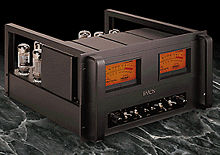 I've
been writing about jazz, blues, rock, progressive pop, R&B, worldbeat, and
classical music since 1976, and along the way developed a near fatal
predilection for good audio. "What'll it be, son—200 watts per side or
conjugal relations with your spouse?" I'm thinking, I'm thinking. However,
unlike some of the solemn, stressed-out tweaks I've encountered over the years
working in record stores and retail audio, the music comes first, you dig?
I've
been writing about jazz, blues, rock, progressive pop, R&B, worldbeat, and
classical music since 1976, and along the way developed a near fatal
predilection for good audio. "What'll it be, son—200 watts per side or
conjugal relations with your spouse?" I'm thinking, I'm thinking. However,
unlike some of the solemn, stressed-out tweaks I've encountered over the years
working in record stores and retail audio, the music comes first, you dig?
Someone once observed that for listeners experiencing a profound emotional response to a piece of music, the quality of the delivery system is incidental. I can't recall if the researcher was an audio engineer or a behavioralist, but we've all experienced this curious aural phenomenon. It's as if the Creator, not merely content to endow us with souls, retrofitted our being with some sort of spiritual Dolby processing, so that if the music was truly inspiring our level of concentration would rise to match it, and we could filter out much of the noise, RF interference, harmonic distortion, and shitty reproduction, and focus in on the music, restoring a level of frequency response and dynamic range commensurate with the gravity of the experience.
But you can't polish a turd.
A case in point: Many years ago when I first got into the music business, a magazine publisher had me and my staff out to his suburban digs for a party. Our host's high-end system was his pride and joy, and he'd purchased his house partly on the basis of the big sunken living room's superb acoustic configuration. Now this cat was a malevolent little Howdy Doody, but his audio system was so screamin' that to this day I accord him a grudging degree of respect. He had a pair of those classic B&W R2D2 jobbers, some bitchin' separates, a beautiful tonearm, moving-coil cartridge and turntable, and a vaulted ceiling that rose like the steppes of a rice paddy over this huge bay window—this snoid had turned his living room into the Hollywood Bowl. The sonic impact was palpable, the soundstage as broad as the Pacific and deeper than the Marianas trench, but Kenny Rogers' The Gambler represented the zenith of our seeker's transcendence.
So am I making a case for listening to Tatum or Horowitz on some jive upright? Of course not—bring on the German Steinways. Am I suggesting that true spiritual seekers can be content with department-store rack systems? May I never experience flat frequency response below 100Hz.
Still, I learned a long time ago that the human being was the ultimate instrument, and that sometimes, in scaling the sacred slopes of Mount Compromise, chance encounters with the goddess of Price-Performance Ratio can transform your humble audio environment to the point where you suddenly find yourself standing on hallowed ground.
Fate knocks
During the past two years a series of oddly providential events overtook me, and
I was finally able to approach something approximating my vision of audio
nirvana. First of all, I got lucky, copped a workable recording budget, and got
to produce an audiophile-quality freeform jazz recording. I was able to assemble
a dream team of great improvising musicians (Ginger Baker, Bill Frisell, and
Charlie Haden) in a magnificent recording studio (Allen Sides's Ocean Way), with
a vintage Studer two-track ½" and an audiophile-quality Focusrite mixing
board (by Rupert Neve), the help of an authoritative, simpatico recording
engineer (Malcolm Cecil), and a superb mastering engineer (Ted Jensen of
Sterling Sound). A lot of my intuitions about sonics, artists, and repertoire
turned out to be dead on, everything clicked, and Going Back Home (Atlantic
82652-2) was widely praised by jazzbos and audiophiles alike.
Then fate tossed what at first seemed like a bean ball, but which upon closer inspection came to resemble Newton's apple. One fine spring morning I looked out my fifth-floor window and discovered that an auto-parts collector had accepted my '82 Toyota on consignment for immediate export to South America. So much for bucolic escapes from Manhattan. But as summer turned to fall, I assuaged my grief with the knowledge that my auto insurance money had gone unspent, and that cash and credit previously set aside to fund my mechanic's weekend retreat were burning a hole in my pocket.
So inspired, I got a great price on a used Conrad-Johnson PV5 tube preamp, and had a set of speakers and passive subwoofers custom-built for me by Elliot Zalayete of Zalytron (featuring Cabasse and Focal drivers). Then this past spring I found myself wandering the portals of the Waldorf=Astoria at Stereophile's HI-FI '96, where I heard any number of superb systems—many of which caused my eyes to mist over and my loins to ache from transducer envy—but I also heard some pricey artifacts in wedding-cake cabinets that left me decidedly unmoved and reassured in my simple peasant wisdom. However, a chance assignation on the ninth floor sent me scurrying back home, and before you could say "capture ratio" I found myself, calculator in hand, contemplating a year or so of peanut-butter sandwiches. I had seen the burning bush.
The system Mesa Engineering's Tom Menrath had set up in their Waldorf suite featured a Wadia 16 CD player employing digital attenuation running direct to the Mesa Baron amplifier. The system used FMS interconnects and speaker wire and Aerial Acoustics Model 10Ts. Even in the abysmal acoustic environment of a hotel suite, the Baron's musicality and transient response were plainly apparent. Then they played a CD that I was very familiar with—Ry Cooder's soundtrack to Paris, Texas (Warner Bros. 25270-2). The clarity, transparency, soundstage depth, and detailed imaging revealed layers of room ambience I'd never perceived.
Baronial
When I got home and put on the same disc, the differences were disconcerting.
Even factoring in the focus and sonic superiority of the Wadia system to my
humble Audio Alchemy unit, it was disconcerting to realize that I'd barely
scratched the potential of my speakers—they laid bare the sonic limitations of
my old amp.
Now, I've been around; listened to all kinds of sounds, experienced a lot of live music, and heard some extraordinary sound systems in my time—I always thought I had pretty good aural reference points. But it was humbling to finally experience just how much sonic impact and dimensionality a great power amp imparts to a sound system. When you visit a fine high-end store, one of the biggest challenges facing a salesman is helping you to zero in on what kind of amp will best suit your system, acoustic environment, and musical tastes. You might be attracted to the warmth and airiness of a low-powered tube amp, but if your listening tastes run beyond jazz and classical to rock, hip-hop, and other highly processed source material, this type of amp probably won't satisfy you in the long run. And while a high-powered solid-state amp might convey the sonic impact and immediacy you crave—especially in the low end—the lack of subtlety and detail on acoustic music may grow tiresome after a while.
Which is part of what makes the Mesa Baron such a remarkable performer—it's a true musical instrument. I'm not going to undertake a technical analysis, A/B it against other amps, or make outrageous subjective claims for it. There are lots of great tube and solid-state amps out there that I'd be thrilled to own. What I will tell you is that the sound of this dual-mono, all-tube amplifier has made me deliriously happy. Its remarkable level of flexibility and musicality recommend it to economically impaired music lovers for whom high-end performance has always been just out of reach—and possibly even to those of you for whom cost is no object.
When I first auditioned my speakers in tandem with the Mesa Baron, I used Emmylou Harris's Wrecking Ball (Asylum 61854-2) to impress my wife. Producer/guitarist Daniel Lanois's avant-garde vision of rustic Americana has lots of ambient detail and some outrageous low end, featuring a clear, bottom-heavy portrayal of the toms and bass drum (recorded with ribbon mikes). Well, her eyes were popping out. "The first time you played me these speakers I was feeling the sound in my pelvis, but now I'm experiencing it right in the heart," she marveled. "Well, there you are," I enthused. "The true tube chakra."
Next we began to experiment with the Baron's most distinctive feature: Tandem State Imaging. Remember what I said about trying to zero in on an amplifier that most nearly accommodated your range of listening tastes? Well, with Tandem State Imaging you don't have to compromise because it's two, three, four, or more amplifiers in one, and you can make choices on the fly—while the music is playing—selecting the operating characteristics and increments of negative feedback that best complement the music, your speakers, and the acoustic environment.That's because the Baron employs a separate duo and quartet of output tubes for each channel, and you can configure the amp so you alternate between class-A triode (at around 60W) or class-AB pentode (at 150W). Most significant, you can employ increments of the two operating modes: either 2/3-triode/1/3-pentode (at around 90W) or 2/3-pentode/1/3-triode at (at 120W), with three increments of negative feedback (or none at all). As a result, you can literally tune this amplifier disc by disc, song by song to best suit a particular recording style or volume level—while the music is on—or to tailor the amp's performance to accommodate different speaker types or room environments.
My speakers are very sensitive, and the 10" Focal bass drivers don't really require much damping, so we generally didn't employ any negative feedback (more on that later). We listened to the Emmylou Harris and a wonderful acoustic duet by Ray Brown and Duke Ellington, This One's for Blanton (Pablo PACD 2310-721-2), which has great room sound, amazing presence, and a lovely low end—and I was aerobicizing myself jumping up and down to switch back and forth between the modes to hear what the tradeoffs were. My wife voted for class-A triode because "It's gentler," and it's hard to beat all-triode for solo instruments, acoustic jazz, and chamber music. There was more air, a broader soundstage, greater separation and distinction between the instruments—it was just a sweeter, more involving listening experience.
Next we listened to a lovely Béla Fleck recording called Tales from the Acoustic Planet (Warner Bros. 45854-2). On a trio rendition of "Arkansas Traveler," Béla's banjo was crisp and sparkling, Edgar Meyer's huge double-bass had resounding presence, and we heard all sorts of pitch manipulations and timbral subtleties in Kenny Malone's brush work and bass drum. Then, on "Backwoods Galaxy" (the next cut, with Chick Corea, Branford Marsalis, and the Wooten brothers), Victor Wooten's electric bass didn't really seem all that present compared to the acoustic bass fiddle on the previous cut, so I switched to 2/3-triode/1/3-pentode and then to 2/3-pentode/1/3-triode. What was really interesting was not just that the bass was more present, but that the actual placement of the instruments began to change. All of a sudden the bass's actual place in the mix became a little more forward, a little more present, and a little more centered in the soundstage.
The soundstage itself was no longer quite as deep, and in exchange for more punch and presence, there was a slight loss in separation and transparency, but not until one turned to full pentode did acoustic sounds begin to harden, sounding as if they were coming through a P.A. If we were living in a huge loft or had very inefficient speakers, then full pentode would make some sense. But in a 12' by 20' space it's tantamount to having a hurricane in your living room—it's simply overkill (although when I first heard full pentode in Mesa's suite at HI-FI '96, it seemed like the most dynamic sound, at polite trade show volume).
As you can imagine, the variables and combinations are limitless. Late at night, when I'm not listening at concert-stage volume, adding increments of pentode power gives the music an appealing sense of liveness and presence. But at my normal listening levels, which are fairly loud, I mostly employ all-triode; at 2/3-triode/1/3-pentode, I seemed to move closer to the stage; at 2/3-pentode/1/3-triode the stage seemed to move closer to me. In listening to modern jazz recordings (like Kenny Garrett's Pursuance) or vintage analog symphonic recordings (such as Bruno Walter's version of Mahler's Symphony 9 or Herbert von Karajan's version of Brahms's Symphony 1) I found myself favoring 2/3-triode/1/3-pentode at more moderate volume levels—which seemed to give the orchestra a little more bottom and presence, without blurring delicate details or sucking all the air out of the room.
But when listening to rock, funk, or electric jazz—contemporary music employing contemporary recording styles, featuring unnatural frequency extremes, where you need fast, massive bursts of power to handle the transients, and the sense of venue is much less decisive—then 2/3-pentode/1/3-triode was the configuration I preferred. It really brought out the larger-than-life qualities in audiophile-class pop recordings such as Wrecking Ball, Little Village, and Turbulent Indigo, electric worldbeat like Jean Luc Ponty's Tchokola, and contemporary jazz like George Benson's That's Right.
And as a stone analog recidivist, I find that on pure digital recordings triode sounds relatively flat and lifeless. In listening to Bob Katz's recording of Oregon's Beyond Words (Chesky JD130), and Mark Levinson's recording of The Carnegie Hall Jazz Band (Blue Note CDP 36728 2), 2/3-pentode/1/3-triode conveyed extra dimensionality and transient impact. On Yoel Levi's Telarc recording of The Rite of Spring, the Baron translated Stravinsky's timpani strokes into big, soft cannonballs of love that leaped out of the speakers and crushed my sternum without mussing my hair.
I only employ full pentode when I'm feeling very frisky or my neighbors are having a party and I choose to up the ante. On King Crimson's live-to-DAT soundboard recording THRaKattak and Sly And Robbie's digital hip-hop anthem Silent Assassin (with KRS-One), the frequency extremes were so wild, the transients so monstrous, I employed negative feedback to tame and localize the bass, even-out the image, and make the highs more distinct. The Baron's three stages of negative feedback seemed to enhance the musical smoothness and focus, but at the expense of some transparency and imaging. But on music such as this, recorded at nosebleed volume levels, where the goal is not to capture room acoustics but to deliver a visceral impact, it's a big help. Stage one of negative feedback in the 2/3-triode/1/3-pentode or 2/3-pentode/1/3-triode modes is very subtle and musical, as I discovered after I listened to a number of recordings without realizing I'd left it on.
But generally, the only time I use negative feedback is when I'm really blasting away on vinyl—the reduced damping factor does help tighten up the bass. In listening to Wilhelm Furtw;dangler conducting Brahms's Symphony 1 (an epic 1952 Deutsche Grammophon treatment that stands shoulder-to-shoulder with Toscanini's legendary RCA Victor 1951 recording), two stages of negative feedback really helped clean up and focus the timpani accents Furtwängler employs to supercharge the giddy accelerandos at the climax of the fourth movement.
Conclusion
As you may have gathered, the Mesa Baron has significantly enhanced my life and
listening environment. I leave it to such aural elders as John Atkinson and Wes
Phillips to draw a definitive conclusion as to the Mesa Baron's rightful place
in the hierarchy of great power amplifiers. But for this aural pilgrim, the Mesa
Baron is the truth, the whole truth, and nothing but the truth. Tandem State
Imaging is a source of endless fascination, and I'm finally able to experience
recorded music at a level of dimensionality and impact heretofore reserved only
for audio salon listening rooms, concert halls, and wealthy high-end enthusiasts.
I wonder what the preamp will be like.—Chip Stern
Sidebar 1: JA listens to the BaronGiving away its professional heritage, the dual-mono Baron has a ground-lift switch for each channel, a guaranteed way of minimizing ground-loop hum. I have no idea why this often essential option is so rare in consumer amplifiers, unless it's a safety/insurance issue. I got the most hum with with one or both channel grounds connected to the system ground, so I lifted them them both for my auditioning.
I spent only a short time listening to my first sample of the Baron, which was dark-sounding as all get-out, especially in triode mode. It turned out that an early production run of 18 samples—including mine—had been fitted with a wrong-value capacitor. As I was about sit at the laptop to dismiss the amplifier in a few choice words, a phone call from Mesa's Tom Menrath informed me that a replacement was already on the way.
Chip Stern wasn't bothered by the "limitless" variations the Baron has to offer. Me, I'm made of less stern stuff. Faced with a choice of output transformer taps, four negative feedback levels, and four operating modes—triode to pentode, with two stops along the way—I spent a weekend ringing the changes with the second sample before settling down with a basic setting which seemed to work best with my Silver Signature speakers. Which was: all-triode, with the negative feedback set to the minimum setting short of none at all. All-pentode was, to my ears, a bust—intolerably bright, at least to my ears. Dynamic, certainly, and the amp played loud with only a smidgen of drive from the preamp, but the sound lacked class. And at my age, class is what I wants from a piece of electronics.
In triode mode, the class was there. Seductively sweet-sounding, in fact. Anything with female voice, anything with those most vocal of instruments, the trombone and the cello, was reproduced with a sense of "body," of being there, that made the music sing. In comparisons with the amplifier I've found to be the best in this area, the single-ended and identically priced Cary CAD-300SEI, the Baron fell a little short, but not by much. And on recordings that had been recorded so as to capture a real soundstage—Keith Johnson's neglected but sonically superb, early HDCD release of virtuoso classical clarinet pieces (Ebony Concerto, Reference Recordings RR-55CD), for example—the Baron threw a huge, spacious dome of ambience around the musicians.
It was at the frequency extremes that the Baron fell short of what I want from an amplifier. The revised amplifier was less dark-sounding than the first sample, but it was still balanced well on the mellow side of neutrality. While this generally didn't get in the way of the music on most recordings, it might be a problem in system matching. The bass was also a problem area in that it failed to kick rhythm sections along with sufficient pace. Charlie Haden's bass on the superb-sounding Ginger Baker Trio album produced by Chip Stern, for example, was just too fat, warm, and nice-sounding to kick much booty. Pleasant, yes, but the tension just wasn't there. As CS mentioned, increasing the negative feedback or changing to partial or all-pentode operation went some of the way toward alleviating this character, but I just liked the low-feedback triode mode too much to be happy with this compromise.
Chip commented positively on the Baron's dynamics. Paradoxically, while it does give an impression of controlled power, I couldn't get the amp to play loud without it starting to sound strained. In my preferred triode mode with Stage I feedback, playing the 20-bit master for Stereophile's Robert Silverman Liszt recording, which I was preparing for LP release, 20W on the meters (which I later measured as indicating a true 20W from the 8 ohm tap into 8 ohms) was about as far as I could usefully push the amplifier. Note that the Baron was not clipping; rather, the sound started to get a bit gritty, and treble grain began to intrude. When I kept the level below 20W I enjoyed what the Baron did with the music; above that level, I reached for the volume control.
"A definitive conclusion as to the Mesa Baron's rightful place in the hierarchy of great power amplifiers," Chip asks for in his part of this review. Looks like the new kid on the reviewing block don't ask for much!
With its high output impedance and progressive distortion characteristic, Mesa's Baron both gives away its music-industry pedigree and reveals its departure from the high-end amplifier norm. Its sound will vary to a much greater extent than usual, depending on the loudspeakers it is asked to drive, and mandating a careful audition before purchase. But when everything does go its way, the Baron will give its owner much musical enjoyment.—John Atkinson
To audition the Baron, I used B&W Silver Signature loudspeakers. Preamplifier was a Mark Levinson No.38S, with a Mod Squad Phono Drive EPS used to amplify LP signals from a Linn Sondek/Cirkus/Trampolin/Lingo/Ekos/Arkiv setup on an ArchiDee table. Digital sources were Mark Levinson No.30.5 HDCD and Parts Connection Assemblage DAC-2 D/A processors driven by a Mark Levinson No.31 transport, a Nagra-D open-reel digital recorder, and a Panasonic SV-3700 DAT recorder via Madrigal and Illuminati AES/EBU cables and Meridian 518 or Genesis Digital Lens jitter-reduction units (No.31, DAT) or Sonic Frontiers UltraJitterbug (Assemblage, Nagra). I also used the impressive Sonic Frontiers SFCD-1 CD player. Interconnects used were AudioQuest's balanced AudioTruth Lapis X3, unbalanced with an adaptor at the amplifier end. All source components and preamps were plugged-in to a Power Wedge 116 Mk.II, itself plugged-in to a dedicated AC circuit and fitted with the Power Enhancer option.—John Atkinson
Sidebar 4: MeasurementsAs I mentioned in my listening report, the Baron offers 32 different combinations of its settings, meaning that for measurement purposes it is 32 different amplifiers. To supply a full set of measurements for every combination wouldn't leave room in this issue for any other reviews! Accordingly, I only thoroughly measured the Baron's all-triode and all-pentode modes, from both the 8 and 4 ohm transformer taps, with the negative feedback set to none or all (labeled Stage III). Other than spot checks on other settings, I'll leave you to infer what happens for the mixed pentode/triode settings. Before I performed any measurements, I took care to optimize the bias and balance for each channel.
First, don't let the XLR input socket mislead you. Pin 2 is wired as "hot," as is usual, but pin 3 was shunted to ground on my sample. This is an unbalanced input. If you use a preamp with balanced output, its "cold" driver will see a short circuit to ground, to its possible distress. (Aware of this loading problem, Mesa now ties this pin to ground with a 60k resistor.) I measured the input impedance as 42k ohms at 1kHz. The amp is wired to be non-inverting.
Given the Baron's dual-mono construction, it was a little disappointing to find the amplifier's channel separation falling to 70dB above 10kHz (not shown). I assume that this is due to the proximity of the two input circuits and the negative feedback switching resulting in some capacitive coupling. Noise levels were low, at typically 76dB (unweighted ref. 1W/8 ohms), this improving to around 86dB when A-weighted, meaning that what noise there was was dominated by very high- and/or very low-frequency components (principally hum).
Voltage gain varied significantly with setting and load, ranging from a very high 39.4dB (all-pentode, zero feedback, 4 ohm tap loaded with 8 ohms) to a more normal 29.2dB (all-triode, Stage III feedback, 4 ohm tap loaded with 8 ohms).
Looking at the output impedance revealed the Baron's musical-instrument amplifier heritage: Whereas a modern hi-fi amplifier is intended to act as a voltage source—its source impedance is so low that its output voltage doesn't drop significantly as the load impedance falls—the Baron's source impedance is intended to be equal to the load. (In this respect, the Baron's output transformers perform very similarly to that of my much-beloved 1970 Fender Bassman 50.) A quick workout with Ohm's Law should convince you that making source and load impedances equal results in maximum power transfer to the load, as paradoxical as that might sound. However, it does mean that half the total power delivered by the amplifier is dissipated in the output transformer—which, as a result, runs very hot. Second, with a real-world loudspeaker, the necessarily high source impedance results in a frequency response that varies significantly according to the speaker's modulus of impedance.
Fig.1, for example, shows the Baron's amplitude response in triode mode (8 ohm tap, zero feedback) into 8 ohms, 4 ohms, and into our dummy loudspeaker load, designed for us by NHT's Ken Kantor. (Described in the August 1995 issue of Stereophile, p.168, this is a collection of resistors, capacitors, and inductors intended to model the impedance signature of a typical two-way, Zobel-compensated, sealed-box loudspeaker.) In triode mode, the HF response rolls off early, being –5dB at 20kHz—there's the mellow top octave I noted in my auditioning. But more important, note the 3dB drop in output level into the lower impedance and the severe modification of the amplifier's response by the dummy load. To a large extent, this amplifier will sound different with every loudspeaker with which it is used. Its 1kHz source impedance varied from 18 ohms (pentode, 8 ohm tap) through 7.75 ohms (triode, 8 ohm tap), to 4 ohms (triode, 4 ohm tap). While the 20kHz impedance was generally a little lower than at 1kHz, at the low-frequency extreme (20Hz) the impedance in the pentode mode was even higher, reaching a maximum of 23 ohms.
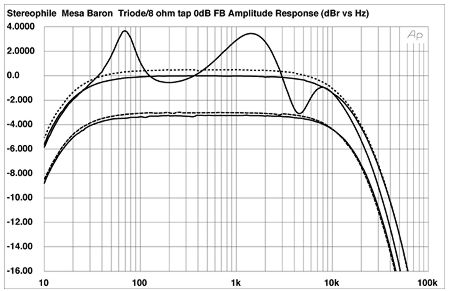
Fig.1 Mesa Baron, triode mode, 8 ohm tap, 0dB feedback, frequency response at (from top to bottom at 1kHz): 2.83V into simulated loudspeaker load; 1W into 8 ohms; 2W into 4 ohms (right channel dashed, 2dB/vertical div.).
Loop negative feedback lowers an amplifier's source impedance; how does changing the Baron's feedback level reduce this interaction? The answer can be seen in fig.2—not much. A swing of ±3.4dB with no feedback is reduced to ±2.8dB with Stage III feedback. And in pentode mode with maximum negative feedback (fig.3—note the different vertical scale on this graph), the swing is even greater, reaching a maximum boost of almost 5dB in the low treble. Here's part of the reason the Baron tended to sound bright with my preferred speakers. Note, however, that the amplifier offers a more extended HF response in pentode mode, only falling by 1dB at 20kHz. This is confirmed by the 10kHz squarewave response (fig.4), which has a reasonable risetime. Note the very slight and well-damped ringing in fig.4, this correlating with the small response peak just above 100kHz in fig.3.
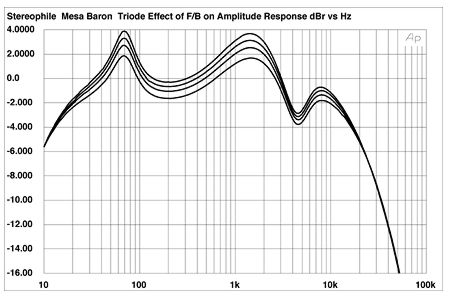
Fig.2 Mesa Baron, triode mode, 8 ohm tap, 0dB feedback, frequency response at 2.83V into simulated loudspeaker load with (from top to bottom): 0dB, Stage I, Stage II, and Stage III feedback (2dB/vertical div.).
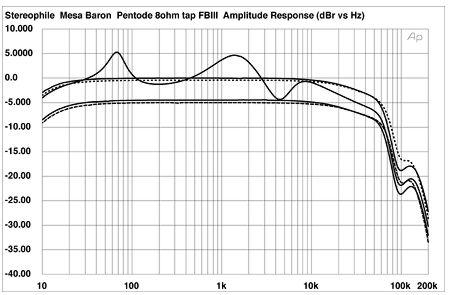
Fig.3 Mesa Baron, pentode mode, 8 ohm tap, Stage III feedback, frequency response at (from top to bottom at 1kHz): 2.83V into simulated loudspeaker load; 1W into 8 ohms; 2W into 4 ohms (right channel dashed, 5dB/vertical div.).
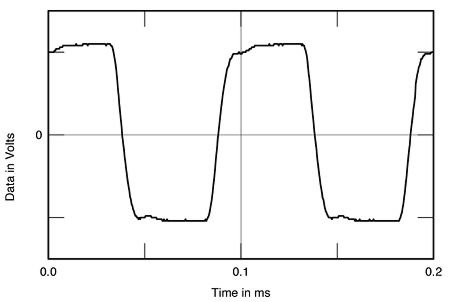
Fig.4 Mesa Baron, pentode mode, 8 ohm tap, Stage III feedback, small-signal 10kHz squarewave into 8 ohms.
When it comes to describing the Baron's distortion performance, there are two opposed ways of looking at it. First, the Baron is overall a relatively non-linear device: Its distortion is typically 10 times higher than you'd find in a modern solid-state design, or even a modern tube design. Second, when you consider its absence of overall loop feedback—even in its highest feedback setting, it only offers a few dB of gain and distortion reduction—its transfer function is actually remarkably linear. The Baron also resembles the human hearing mechanism in that its distortion increases in proportion to level.
This can be seen from fig.5, which shows the THD+Noise percentage on a 1kHz tone plotted against output power into 8 and 4 ohms, with the amplifier in triode mode with 0dB feedback. Below 50mW (0.05W), the curve starts to rise, meaning that the figure is actually dominated by noise below this power level. The minimum value of 0.1% at the 50mW level is actually the amplifier's basic level of distortion at these minimal power levels, which is acceptably low. But as the output power rises, so does the THD, but in what appears to be straightforward manner. The clipping point in triode mode (defined as 1% THD+N) into both 4 and 8 ohms is around 20W. But note that the "knee" in the amplifier's output plot lies at the 2% level. Relaxing our definition of clipping to 3% THD+N therefore results in a maximum power output of 55W into 8 ohms (17.4dBW), agreeing with the specification.
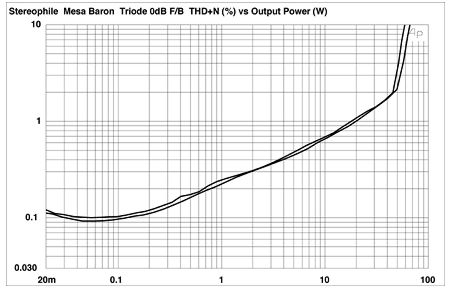
Fig.5 Mesa Baron, triode mode, 8 ohm tap, 0dB feedback, distortion (%) vs output power into (from bottom to top): 8 ohms and 4 ohms.
I suspect that it was this increase in distortion level with increasing level that caused me to find the Baron's dynamics limited in triode mode. Remember that I found about 20W to be the practical limit. Remember also that the emphasis of the low-treble region with the two-way speakers I use (see fig.1) will help unmask distortion products. The effect of changing the feedback level on the output power curve is shown in fig.6. The clipping point doesn't change, but each increase in negative feedback results in slightly lower distortion at lower power levels.
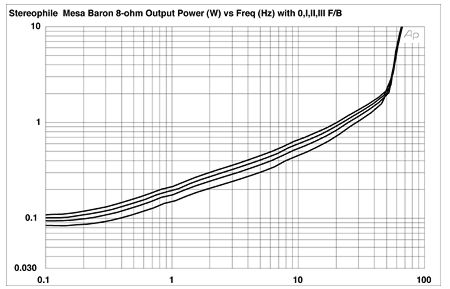
Fig.6 Mesa Baron, triode mode, 8 ohm tap, 0dB feedback, distortion (%) vs output power into 8 ohms with (from bottom to top): Stage III, Stage II, Stage I, and 0dB feedback.
In pentode mode, the amplifier behaves somewhat differently. Fig.7 shows the Baron's THD+N plotted against output power driving 8, 4, and 2 ohm loads from its 4 ohm tap. (The feedback level was Stage III.) First, note that, even allowing for the effect of the feedback, the overall distortion level is lower than in triode mode. Second, the output power is considerably higher, the 4 ohm power from the 4 ohm tap equaling 135W at the 3% THD point (18.3dBW). Into 8 ohms, the pentode Baron's 8 ohm tap raised 140W (21.5dBW), the 4 ohm tap 100W (20dBW).
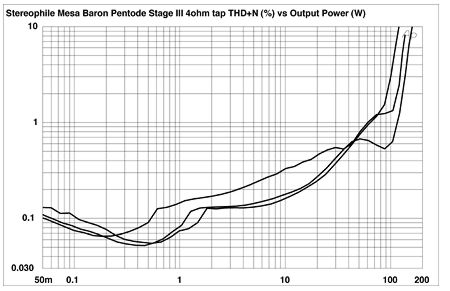
Fig.7 Mesa Baron, pentode mode, 4 ohm tap, Stage III feedback, distortion (%) vs output power into (from bottom to top at 10W): 8 ohms, 4 ohms, and 2 ohms.
However, this was for a 1kHz signal. Even with the maximum feedback, the pentode mode's distortion rises for both higher and lower frequencies (fig.8). While this was also true for the triode mode (fig.9), the differences were less extreme. And what about the influence of feedback? Fig.10 shows the difference between the THD+N vs frequency plot in triode mode for the two extreme settings, driving 8 ohms from the 8 ohm tap. While the Stage III feedback basically halves the level of distortion, note that the right channel is already much better than the left above 1kHz. Even though I carefully set up the output-tube bias and balance, there will always be some variability in performance.
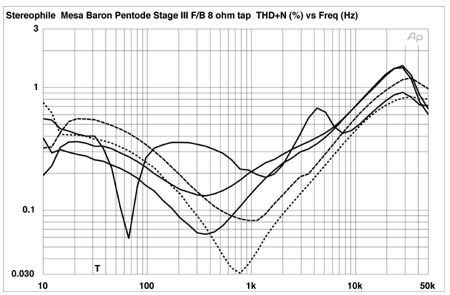
Fig.8 Mesa Baron, pentode mode, 8 ohm tap, Stage III feedback, THD+noise vs frequency at (from top to bottom at 5kHz): 4W into 2 ohms, 2W into 4 ohms, and 1W into 8 ohms (right channel dashed).
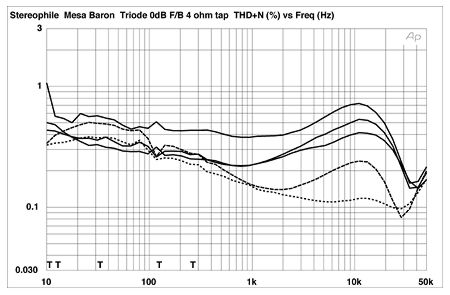
Fig.9 Mesa Baron, triode mode, 4 ohm tap, 0dB feedback, THD+noise vs frequency at (from top to bottom at 10kHz): 4W into 2 ohms, 2W into 4 ohms, and 1W into 8 ohms (right channel dashed).
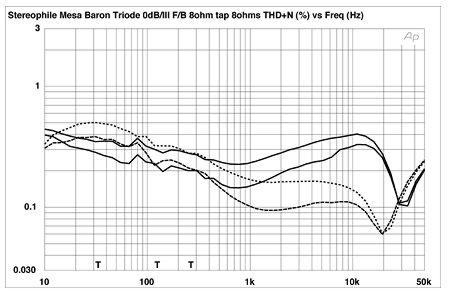
Fig.10 Mesa Baron, triode mode, 8 ohm tap, THD+noise vs frequency at 1W into 8 ohms with (from top to bottom): 0dB and Stage III feedback (right channel dashed).
As Scott Frankland discusses elsewhere in this issue, more important than the level of distortion is its nature. Remember that I much preferred triode mode? Fig.11 indicates that the main harmonic present is the benign second, with a touch of fourth. But in pentode mode under the same conditions (fig.12), some jagged-looking spikes appear in the distortion waveform, suggesting the presence of higher-order harmonics. Even though the level of THD is still quite low—around 0.14%—there is plenty of evidence in the pyschoacoustic literature that this kind of distortion spectrum is subjectively more dangerous. Add this to the more severe modification of the amplifier's frequency response in pentode mode (fig.3), and you probably have the explanation for why I didn't much like pentode operation, and why Chip's wife commented that triode operation was "gentler."—John Atkinson
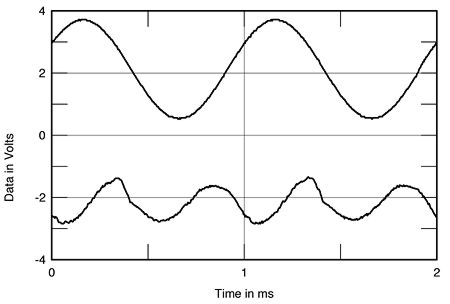
Fig.11 Mesa Baron, triode mode, 4 ohm tap, 0dB feedback, 1kHz waveform at 2W into 4 ohms (top); distortion and noise waveform with fundamental notched out (bottom, not to scale).
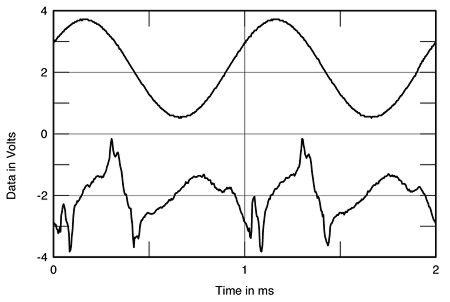
Fig.12 Mesa Baron, pentode mode, 4 ohm tap, 0dB feedback, 1kHz waveform at 2W into 4 ohms (top); distortion and noise waveform with fundamental notched out (bottom, not to scale).
| Mesa Engineering Web Site 1317 Ross Street |
||
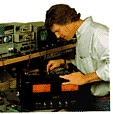
Tri-tube mod allows choice of power tubes ranging from 5881 to
KT90
tubes. The amp is currently equipped with two matched sextets of
Tesla/JJ E34L power tubes and four Sovtek 12AX7LPS pre and driver
tubes. The current set of tubes have been in use for less than 300
hours (a conservative guess).
The cosmetic condition of the amp is VERY GOOD (a few streaks of paint
missing from the front handles). The sonics of the amp are EXCELLENT.
If you enjoy tubed amplifiers, the factory tri-tube modified Baron
allows ample flexibility in achieving the next level of musical
pleasure.
If you are not familiar with the Mesa Baron amp, please visit the web
site below for specs and reviews.